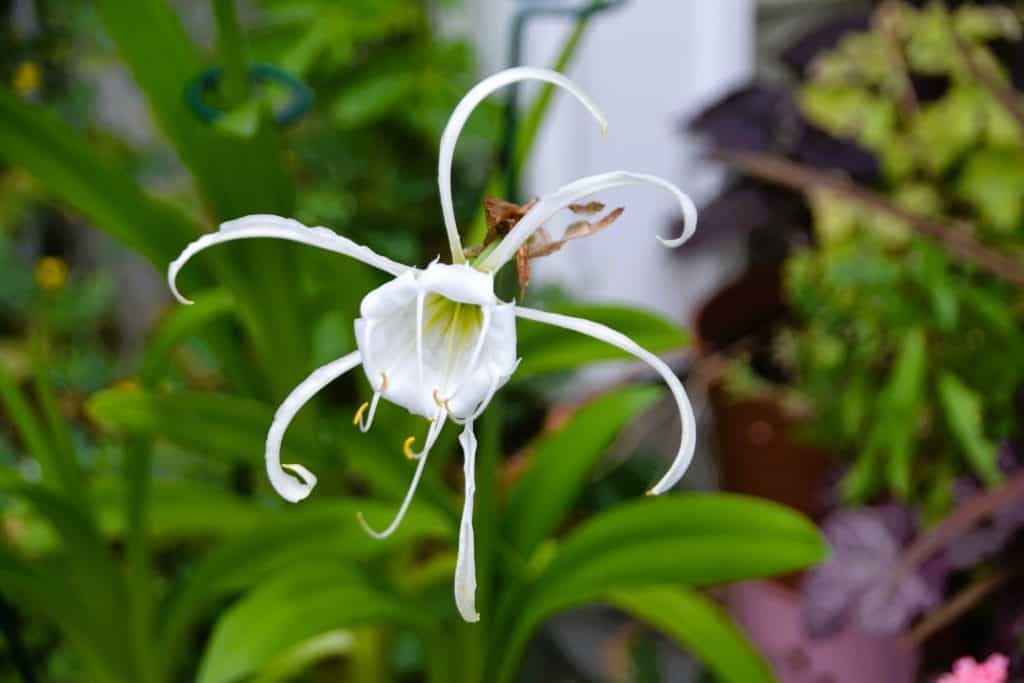Here’s what’s blooming in town this week to make your walks more enjoyable
By Laura Eisener
Today, August 1, is a very old holiday in parts of Great Britain, in which loaves of bread are brought to the church to be blessed, as an appreciation or prayer for a good grain harvest. Members of the grass family, such grains as wheat, barley, rice and corn (maize), are valued around the world as important food crops. It is related to the Gaelic harvest festival Lughnasadh, also spelled Lughnasa, a pagan event celebrating the time about halfway between the summer solstice (June 20) and autumn equinox (September 22). Today is also national spider man day! Perhaps we could extend this to appreciate the benefits spiders usually contribute to the garden, including control of plant pests, mosquitoes and flies.
Speaking of spiders, spider lily (Hymenocallis latifolia) is a tender bulb from South America sometimes called Ismene, Peruvian daffodil or basket flower. The fragrant flowers are usually white with long narrow sepals that extend out beyond the fused, trumpet shaped corolla. It is easy to see where the name spider lily came from because of those narrow sepals, but unlike actual spiders there are only six rather than eight “legs.” Like gladiolus and other tender bulbs, they can be stored indoors in a dormant state over the winter and replanted in spring — placed outside when the temperatures warm up sufficiently. Like most of our hardy bulbs, the flowers do not last a long time, and the foliage needs another month or so to ripen to ensure new flowers in the following growing season.
I look forward to the first blooms of the cardinal flower (Lobelia cardinalis) every summer. This bright red flowering perennial grows in shade or sun, although it needs more moisture in sunny locations. It attracts hummingbirds, which are drawn to the bright red color of the blossoms. In the wild, cardinal flowers usually grow in the woods or near the edges of ponds, and they can often be seen in these areas in southern and northern New England.
The most noticeable plant near the Iron Works house is the smoke tree, also known as European smoke bush (Cotinus coggygria), since its size and shape places it on the borderline of the definitions of tree and shrub. Some years the “smoke” is especially thick, and this is one of those years, since it nearly covers the foliage. This “smoke” is actually the fine textured flower stalks, and it remains most of the summer because even though the flowers have gone by, it holds onto the small seeds until they are ready to be released. Like milkweed “fluff,” these lightweight stalks often break off with the seed and help it to drift away from the parent plant into new locations where it may have a better chance of growing. Some varieties of this species have colorful foliage, such ‘Royal Purple,’ which has dark purple or wine-colored foliage, or ‘Golden Spirit,’ which has yellow-green leaves through the growing season.
While buttonbush (Cephalanthus occentalis) is a very common shrub in our area; often found along the edges of ponds and streams, it is not frequently seen in gardens. It is a real attention getter, though, when the spherical flower heads bloom, and is one of my favorite shrubs. The honey scented blossoms attract many bees and other pollinators and always draw attention as cut flowers in bouquets. In some parts of the country, it is known as buttonwillow. This species has a very broad range across the country. A community in California, formerly named Buena Vista but now known as Buttonwillow, is the location of the largest one in the country, famous as a 19th-century trail marker and now a California historic landmark. My two shrubs are thriving next to my house in a shady and not especially wet location.
While adult monarch butterflies (Danaus plexippus) appreciate nectar from a wide range of flowers and seem to be especially drawn to butterfly bush (Buddleia davidii), as seen in the July 18 column, in order for the next generation to thrive the eggs must be laid on a milkweed plant. Common milkweed (Asclepias syriaca), butterfly weed (Asclepias tuberosa) and swamp milkweed (Asclepias incarnatus) are all native species that will work. All three are now widely available in nurseries. Swamp milkweed is a tall perennial with flowers that are usually pink (‘Cinderella’) or white (‘Ballerina’). As the common name implies, this species likes soils that are somewhat on the wet side, although it does not really need to be swampy.
Editor’s Note: Laura Eisener is a landscape design consultant who helps homeowners with landscape design, plant selection and placement of trees and shrubs, as well as perennials. She is a member of the Saugus Garden Club and offered to write a series of articles about “what’s blooming in town” shortly after the outbreak of the COVID-19 pandemic. She was inspired after seeing so many people taking up walking.




